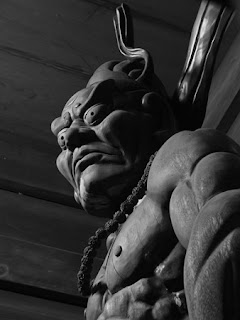Kongōrikishi are usually a pair of figures that stand under a separate temple
entrance gate usually called Niōmon
in Japan, Heng Ha Er Jiang in China and Geumgangmun in Korea.
The right statue is called Misshaku Kongō and has his mouth open,
representing
the vocalization of the first grapheme of Sanskrit Devanāgarī (अ) which is
pronounced "a".
The left statue is called Naraen Kongō and has his mouth
closed, representing the vocalization of the
last grapheme of Devanāgarī (ह
[ɦ]) which is pronounced "ɦūṃ" (हूँ).
These two characters together symbolize the birth and
death of all things. (Men
are supposedly born speaking the "a" sound with mouths open and die speaking
an
"ɦūṃ" and
mouths closed.) Similar to Alpha and Omega in Christianity,
they signify
"everything" or "all creation". The contraction of both is Aum (ॐ), which is Sanskrit for The
Absolute.




















0 件のコメント:
コメントを投稿